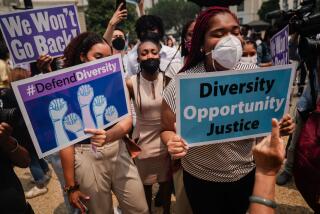PLATFORM : Affirmative Action: Does It Open Doors or Stigmatize Those Who Benefit?
- Share via
Affirmative-action programs are under fire. One of the key battles will be the proposed California civil-rights initiative. If it qualifies, the 1996 ballot measure would forbid race- and gender-based preferences in state employment, contracting and school admissions. Here, JAMES BLAIR talks with backers and opponents.
CHARLES A. LOFGREN
Professor of American history and politics, Claremont McKenna College, author of “The Plessy Case” on the constitutional origins of the separate-but-equal doctrine
Affirmative action runs against the American proposition that all men are created equal. Minorities are stigmatized, regardless of their actual attainments, by the appearance of having undeservingly benefited and a backlash develops generally.
You’ll find instances that could count as success stories. But you have to ask whether those individuals might not have done as well under a regime of equal opportunity. To the extent that the civil-rights movement reminded us that equal opportunity is essential to the American experience, it was good. We have to continue to be reminded of that. But that’s a lot different from awarding benefits and discriminating on the basis of race, which I think affirmative action does.
PHYLLIS OWENS
Credit and collections supervisor, Carson, chapter chairperson of Nine to Five Los Angeles Working Women, an office workers’ advocacy group
Affirmative action is a process of employers going out of their way to find qualified people from groups previously overlooked or given less opportunity. We don’t want employers to lower standards to accommodate unqualified people; we do want them to widen their standards to include more qualified people.
There’s a concentrated effort to close doors again when, in fact, the doors have not swung wide open but have merely been left unlocked. I don’t see the doors have been removed from people’s thinking. We still need affirmative action to keep consciously in front of employers that they should be widening the possibilities for qualified people, not narrowing them.
JOE GELMAN
Civil Service commissioner, City of Los Angeles
Affirmative action played a very, very useful role in opening the doors to many people who were wrongly locked out of the system. But we have reached the point of diminishing returns on these policies. At some point, it stigmatizes those who are supposed to benefit in that they ultimately would not be perceived as having achieved success on merit but rather through preferential treatment. We need to move away from judging people by their skin color or chromosome count.
The California civil-rights initiative returns us to the original intention of the 1964 Civil Rights Act. It simply eliminates discrimination and preference quotas based on race and gender. It does not, however, preclude the possibility of affirmative action based on socioeconomic considerations. That is certainly within the spirit of Martin Luther King Jr.’s speech in 1963.
When it began, people understood affirmative action to be like training wheels, which in time have to come off.
RUBEN JAUREGUI
Principal in a statewide accounting firm, former president of the Latin Business Assn.
People may be under the misimpression that affirmative action applies to private industry when, in fact, in California, affirmative-action goals apply almost exclusively to public agencies and some investor-owned public utilities. And not every local agency has them. Keep in mind that these are only goals, not set-asides. That’s another huge misunderstanding that unfortunately gets played up by the opponents of affirmative action, the governor included.
Without those goals, California’s economy could be crippled in the long term. Most participating minority firms are small and, in most cases, are subcontractors to larger contractors. Absent these goals, those smaller firms would never have the opportunity to compete. At the state level, Hispanic-owned businesses barely reach 1% of the state’s purchases, 3% for all minorities, even though the goal is 15%.
JAMES COLEMAN
President of Americans for United and Strong America, Culver City
I was very active during the civil-rights movement, very much a protester. I was at the Chicago Democratic Convention in 1968, on the outside. So I’ve had my problems with America in the past. But now we really have to rally around the flag, so to speak.
The civil-rights initiative movement is a defense against people who feel their group interests are more important than the majority interest of the country.
Multiculturalists, of course, will say those of us who want to see one America are racists if we’re white and stupid if we’re not. They’re not stopping to think that the reason they’re able to protest in the streets and call us names is that there is this America--that’s important to us and people all over the world.
We can’t lose sight of the bigger picture: This is about the survival of the American philosophy and culture, not just who’s getting public aid.
BILL GALLEGOS
Project director for Los Angeles Alliance for a Drug-Free Community
The rationale for affirmative action was that there is systemic, historically rooted institutional racism in our country that denies equal opportunity and access to higher education, employment, promotion, public office and so on to women and people of color. I think that rationale continues to operate and it needs to be acknowledged and redressed through some public policy. Voluntary programs have historically proven to be pretty consistently a failure.
We should look at major institutions--the Fortune 500, academia, the media--and see what the ratio of people of color is, not only in terms of raw numbers but in terms of authoritative positions. We see, for example, that most of the mainstream media is dominated by white males. That hasn’t changed.
More to Read
Get the L.A. Times Politics newsletter
Deeply reported insights into legislation, politics and policy from Sacramento, Washington and beyond. In your inbox three times per week.
You may occasionally receive promotional content from the Los Angeles Times.










